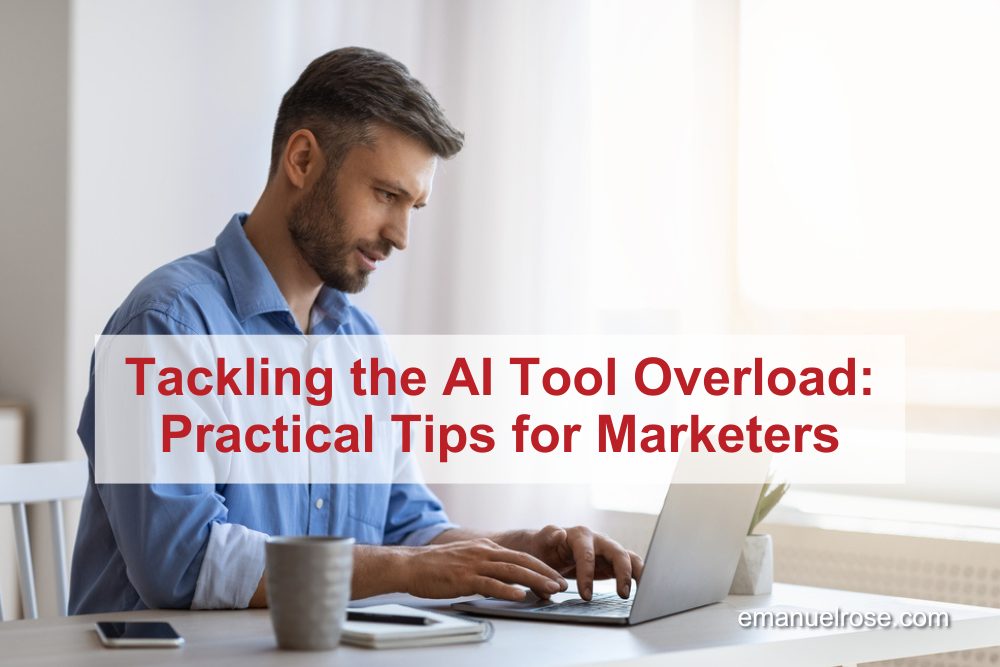Practical Tips for Marketers
As a marketing professional with three decades of experience, I’ve seen technological trends come and go. However, the rise of AI is more than just a trend; it’s a fundamental shift in how we operate. In this blog, I’ll discuss the overwhelming array of AI tools available, how to manage this complexity and provide pragmatic advice for marketers who are just beginning to explore AI’s potential.
Understanding the Overwhelming Array
One of the foremost challenges facing marketers today is the sheer volume of available tools. With the development of AI, this problem has exponentially grown. According to Chief Martech’s latest report, over 14,000 marketing technology tools are available as of May 2024. Layer AI tools on top of that, such as those found on aggregators like “There’s an AI for That,” and the number skyrockets to over 26,000 different tools.

Historically, the marketing technology landscape has gradually expanded, but AI’s introduction has accelerated this growth to an unprecedented rate. For example, from sophisticated ads analytics tools used by big agencies to user-friendly platforms like Constant Contact or Mailchimp, the diversity of tools available is staggering. The rapid development and integration of AI tools, spurred by the success of applications like ChatGPT, has further multiplied the options marketers need to consider.
This abundance leads to what can only be described as overwhelm. Marketers, particularly those new to AI, find themselves inundated with options. It’s difficult to discern which tools provide genuine value and which are less useful. This sentiment resonates widely, whether you’re an agency owner or a small business marketer trying to keep pace with rapid advancements.
How to Manage the AI Tool Maze

Step 1: Develop a Basic Understanding of AI
The first piece of advice is foundational: educate yourself about what AI is and what it does. Many marketers are technologically savvy yet hesitant to adopt AI fully. This hesitation often stems from a lack of understanding. The solution? Integrate AI into your daily routine in small, manageable ways.Modern smartphones offer easy access to AI through apps like Google and Bing. For example, try comparing answers from traditional search functions with those generated by AI features integrated into these apps. This simple exercise can provide valuable insights into how AI operates differently from conventional tools.
Step 2: Start with Your Needs, Not the Tools
Rather than rushing to explore the latest AI tool, start by identifying what problem you’re trying to solve. For instance, if you struggle with writing engaging email content, look specifically for AI tools that excel in copywriting. Common marketing challenges such as social media management, SEO optimization, and customer analytics can be effectively addressed by targeted AI solutions. This problem-first approach ensures that your exploration is both targeted and effective.
Step 3: Experiment with Multiple Tools
Once you’ve identified your needs, don’t settle for the first tool you find. Evaluate several options to see which works best for you. Factors like user experience and interface are crucial, as the best tool for one marketer might not be the best for another. For instance, AI-driven tools like Grammarly can aid in improving content quality, while platforms like Hootsuite can enhance social media management through AI analytics.
Step 4: Understand the Limitations
AI’s capabilities are impressive but not limitless. Recognize that the initial outputs of generative AI often require refinement. A successful strategy involves prompting the AI with specific, detailed instructions. Pointing AI to existing content that matches your desired style can improve outcomes.
However, even with precise prompts, human oversight is essential to fine-tune the results. AI can produce a solid first draft, but human creativity and finesse are required to create polished, client-ready content.
Practical Use Cases of AI in Marketing
Generative Copywriting
Generative AI has been transformative for copywriting, yet it’s crucial to remember that initial outputs usually need refinement. A successful strategy involves prompting the AI with specific, detailed instructions. For instance, pointing AI to existing content that matches your desired style can improve outcomes.
However, even with precise prompts, human oversight is essential to fine-tune the results. AI can produce a solid first draft, but human creativity and finesse are required to create polished, client-ready content.
Beyond Copywriting: Expanding AI’s Role

Moreover, AI can help marketers assist clients in other areas of their business, such as change management, leadership development, and creating customer delight programs. These are areas where traditional marketing tools don’t typically venture, yet they can significantly enhance overall business performance.
To illustrate, consider a business aiming to improve its customer service. AI-powered chatbots can handle a significant portion of customer inquiries, providing quick and accurate responses while freeing up human agents for more complex issues. In addition, AI-driven analytics can help businesses understand customer behavior and preferences, enabling more personalized marketing strategies.
AI offers unprecedented opportunities, but its complexity can be daunting. By starting with a solid understanding of AI, focusing on your specific needs, and experimenting with multiple tools, marketers can harness the power of AI without feeling overwhelmed.
As we move forward, it’s crucial to remain adaptable and continue learning. AI technology is rapidly evolving, and today’s solutions might become even more sophisticated in just a couple of years. By keeping an open mind and continually refining your approach, you’ll be well-positioned to capitalize on the boundless opportunities AI offers.

